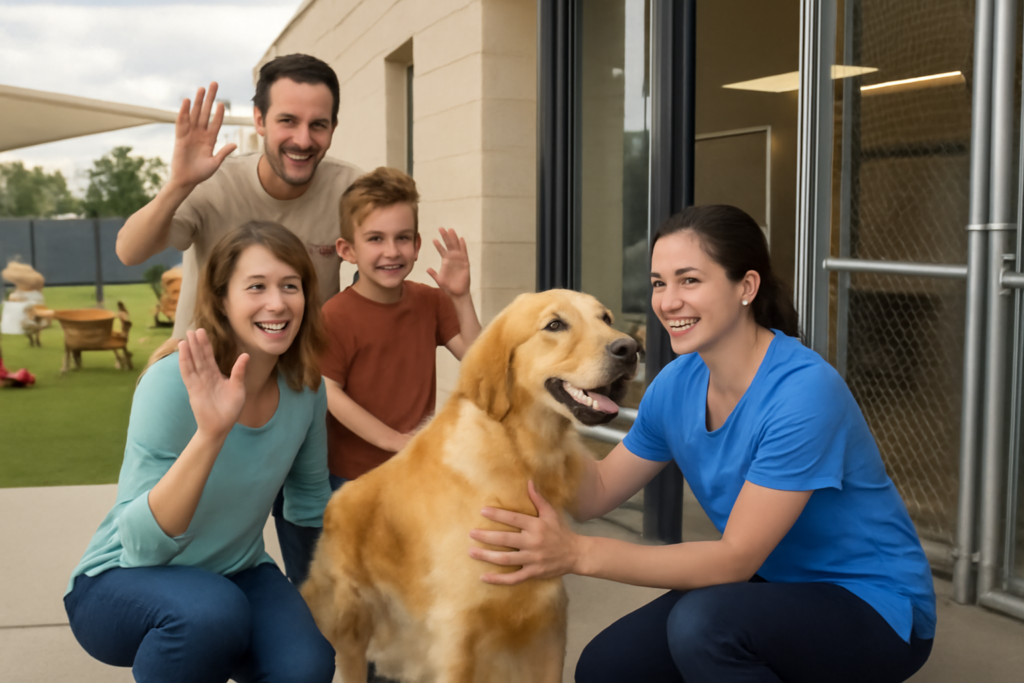
What is a Dog Boarder? In Short Answer
A dog boarder provides temporary care for dogs when their owners are unavailable. Depending on the type of service, this might take place at a kennel, a specialized facility, or even inside the boarder’s own home. Dog boarding ensures that dogs receive food, exercise, and attention while their owners are away.
What is a Dog Boarder?
A dog boarder is someone or an organization that provides short-term care for dogs when their owners are not available. The concept is similar to child daycare or sleepaway camp but designed for pets.
- Professional dog boarders usually operate licensed facilities or in-home boarding businesses. They follow strict safety standards, provide structured routines, and may even offer additional services such as training or grooming.
- Informal arrangements might involve leaving your dog with a friend or relative. While this can work in some situations, professional boarders generally offer more reliable, structured, and secure care.
Dog boarding is not just about feeding and housing a pet; it’s about ensuring the dog feels safe, engaged, and cared for in a setting away from home.

Why Dog Owners Use Boarding Services
Dog owners turn to boarding for a variety of reasons:
- Travel: Vacations, work trips, or visiting family can require leaving pets behind.
- Work schedules: For professionals with long hours, boarding may provide consistency and care.
- Emergencies: Last-minute situations (hospital stays, family issues) may require quick boarding arrangements.
- Peace of mind: Owners want reassurance that their dog is safe, well-fed, and not left alone for extended periods.
In short, boarding offers both practical solutions for owners and emotional security knowing their dog is cared for properly.
Types of Dog Boarding Services
Not all dog boarding is the same. Here are the main types available:
1. Traditional Kennels
- Often resemble large facilities with multiple runs or cages.
- Provide the basics: feeding, exercise, and shelter.
- Typically the most affordable option.
2. Luxury Boarding Facilities
- Designed like pet hotels, offering private suites, play areas, webcams, and even spa treatments.
- Costlier but provide a more homelike environment.
3. In-Home Boarding
- Dogs stay with a boarder in their private home.
- Offers a cozier, more personalized experience.
- Ideal for dogs that prefer small groups or less stress.
4. Dog Training Boarding Schools
- Combines care with structured training programs.
- Dogs learn obedience, socialization, or specific skills during their stay.
- Great option for owners who want progress in training while away.
5. Dog Daycare with Overnight Options
- Functions like daycare but also provides overnight stays.
- Perfect for dogs who already attend daycare regularly.
Qualities of a Good Dog Boarder
When evaluating a boarding service, look for:
- Safety measures: Secure fencing, emergency procedures, trained staff.
- Clean environment: No strong odors, clean kennels, and organized spaces.
- Staff qualifications: Knowledgeable in dog behavior, first aid, and handling.
- Emergency preparedness: Access to local vets, clear health protocols.
- Reviews/testimonials: Honest feedback from past clients.
These qualities indicate a trustworthy and professional environment for your dog.
What Happens When a Dog is Boarded?
Most boarding facilities follow a structured daily routine, including:
- Feeding: Meals given according to owner instructions.
- Exercise: Walks, playtime, or group activities.
- Socialization: Interaction with other dogs (if appropriate).
- Rest: Safe, quiet spaces for sleeping.
Example Schedule:
| Time | Activity |
|---|---|
| 7:00 AM | Morning potty break |
| 7:30 AM | Breakfast |
| 9:00 AM | Group play or individual walk |
| 12:00 PM | Rest/nap time |
| 2:00 PM | Afternoon activity |
| 5:00 PM | Dinner |
| 7:00 PM | Evening walk/play |
| 9:00 PM | Bedtime |
Dogs may take a few days to adapt, but most adjust well once they feel safe and cared for.
Dog Boarding vs. Dog Sitting
Here’s a quick comparison:
| Aspect | Dog Boarding | Dog Sitting |
|---|---|---|
| Environment | Facility or home of boarder | Dog’s own home |
| Socialization | Often interacts with other dogs | Usually limited |
| Supervision | Multiple staff members | One sitter |
| Cost | Varies (can be more affordable) | May cost more for in-home care |
| Best for | Dogs who enjoy routine and interaction | Dogs who prefer staying at home |
Both options work, but the choice depends on your dog’s temperament and your preferences.
Benefits of Dog Boarding for Dogs
- Socialization: Interaction with other dogs and humans.
- Routine: Structured schedules reduce anxiety.
- Attention: Constant supervision keeps them safe.
- Reduced loneliness: Dogs are not left alone all day.
Challenges of Dog Boarding
While boarding is beneficial, it’s not without challenges:
- Stress: Some dogs experience separation anxiety.
- Cost: Quality boarding can be expensive.
- Adjustment period: It may take a few visits for dogs to feel fully comfortable.
How to Choose the Right Dog Boarder
- Research: Read reviews, ask for recommendations.
- Visit in person: Tour the facility or home.
- Ask questions: About feeding, exercise, emergencies, and staff-to-dog ratios.
- Red flags: Dirty environments, lack of staff knowledge, or unwillingness to answer questions.
Preparing Your Dog for Boarding
- Vaccinations: Ensure shots (rabies, bordetella, distemper) are up to date.
- Packing list: Food, favorite toy, bedding, and medication.
- Trial stays: Start with short visits to ease the transition.
Costs of Dog Boarding
- Average pricing in the U.S.: $25–$85 per night depending on location and services.
- Luxury facilities: $75–$150 per night.
- In Hernando, MS & Memphis, TN: Expect $30–$50 per night at standard kennels and $60+ for premium options.
Factors influencing cost:
- Location.
- Size of dog.
- Level of care (training, grooming, private rooms).
FAQs (2.0)
Yes, when choosing a licensed, well-reviewed facility with trained staff.
From overnight up to several weeks, depending on the facility’s rules.
Yes, but most adjust quickly with attention and structured care.
Kenneling usually refers to basic care, while boarding may include enrichment, play, and more personal attention.
If your dog is vaccinated, socialized, and can handle short separations, they’re usually ready.
Yes, but most facilities require puppies to be fully vaccinated (usually around 4–6 months old).
Conclusion
A dog boarder provides peace of mind for owners and a safe, structured environment for dogs. Whether you choose a kennel, in-home care, or a luxury facility, the key is to find a trusted provider that prioritizes your pet’s health, safety, and happiness.
By preparing in advance and carefully choosing a boarder, you’ll ensure your dog has a positive experience while you’re away.
